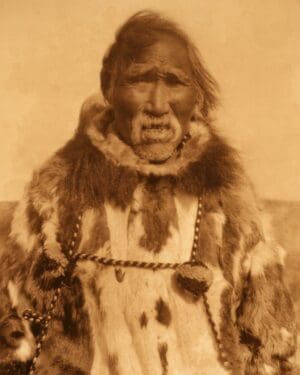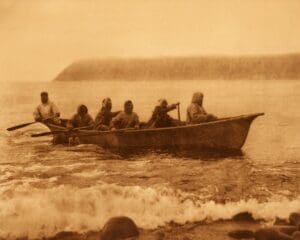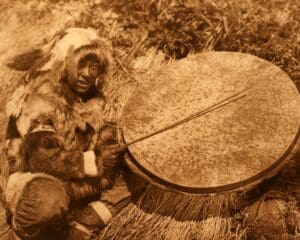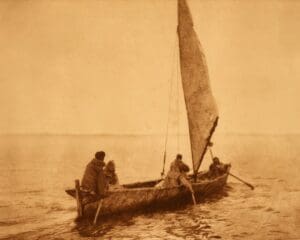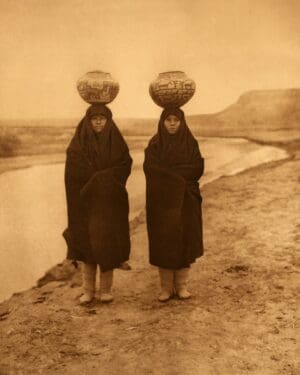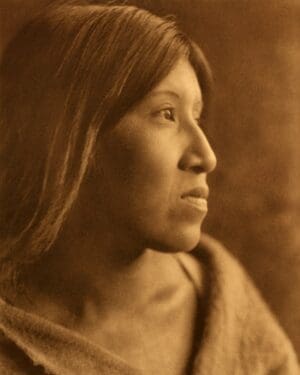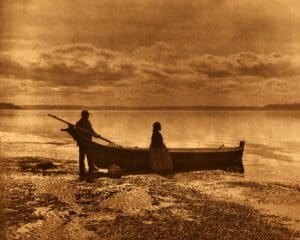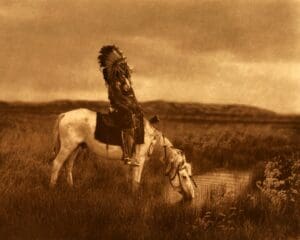Eskimos
Eskimo Photos by Edward S. Curtis
Tribal Summary
Dress
Both Eskimo sexes wear the parka, a frock-like garment reaching to the knees. The pattern is similar for both men and women, except that there is an open seam on each side of the bottom hem of the women’s parka. Parkas intended for outdoor wear have an attached hood which is pulled over the head or allowed to remain folded at the back of the neck. Indoor parkas are lighter in weight. Parkas are made of bird-skins (duck, gull or loon) or of animal skins (caribou, mink, muskrat or squirrel). The waterproof parka for use in rainy weather, in choppy seas when in kayaks, or while hunting, is made of seal-intestine. Men and boys may wear tight-fitting fur caps. Trousers for both sexes are made of seal- or caribou skins; those of the men end at the ankles, while women’s trousers are of full length and have crimped soles for the feet. Boots for men are of knee height, have crimped soles, and are secured with thongs passed over the instep and around the ankle. Boots are made of sealskin, or of the skin of some other animal, with the hair on. The waterproof boot is hairless. Grass pads and sometimes woven grass socks are worn inside the boots to absorb moisture. Mittens, some having a forefinger, are worn in cold weather. The facial decoration for men consists only of la brets, carved ivory plugs worn in apertures below the extremities of the mouth.
Women wear elaborate labrets, earrings, and often nose-beads on ceremonial occasions. Tattooing, affected by women only, is in parallel lines extending from the comers of the mouth to the chin, and sometimes in lines about the wrist.
Dwellings
Permanent and winter houses were (and still are in outlying places and amongst the natives who resist the influences of civilization) of semi-dugout construction. The height of such dwellings is a bout seven feet, four feet of which is underground; the horizontal dimensions range from eight to eighteen feet square. The framework and rafters consist of wooden beams overlaid with split timbers, the whole covered deeply with earth and sod. The long entranceways serve as storehouses for equipment of all kinds. On Nunivak island the houses are connected with tunnels. The men’s houses (community club-houses) and the women’s houses, where such exist, are the largest. These dwellings are similar, in the main, but often vary in details of construction in the different villages. The summer and winter houses on King island are box-like structures, consisting of a living-room proper, and a storeroom erected on stilts which in turn rest on terraces dug out of the steep cliff. Summer and camp habitations, now mostly canvas tents, formerly were light, unsubstantial structures, such as the skin-covered conical hut; the round, skin-covered shelter of the Cape Prince of Wales people; the semi-cylindrical shelter covered with bark, moss, or grass, used by the Selawik; or the square, bark covered hut of the Kobuk.
Food
Birds, such as auk, duck, geese, snipe, and ptarmigan, in seasons of migration are so numerous as to be easily killed. Sea and river varieties of fish, such as cod, herring, pickerel, salmon, smelt, trout, and whitefish, form important food. Edible plants, collected during the brief summer season, are the Alaskan potato, blackberry, blueberry, salmonberry, cranberry, cowslip, dock-leaves, wild cabbage, and wild parsnip. Inland river Eskimo depend chiefly on caribou (now reindeer) for meat, trading with the coast Eskimo for blubber, meat, and oil of sea-animals, except when family groups travel to the coast for hunting. All of the coast and island peoples catch seal, the chief staple food; the Diomede, King Island, and Nunivak peoples obtain many walrus; the Diomede and Cape Prince of Wales groups are noted as whale-hunters. The blubber, meat, and oil of sea-animals form the most important food staples of the coast and island dwellers.
Showing 1–9 of 35 results
-
Sale!

A Kotzebue man
$18.95 – $120.95 -
Sale!

Arriving home – Noatak
$18.95 – $120.95 -
Sale!

Boys in kaiak – Nunivak
$18.95 – $120.95 -
Sale!

Cape Prince of Wales man
$18.95 – $120.95 -
Sale!

Charlie Wood – Kobuk
$18.95 – $120.95 -
Sale!

Diomede boat crew, Asiatic shore in distance
$18.95 – $120.95 -
Sale!

Drummer – Nunivak
$18.95 – $120.95 -
Sale!

Family group – Noatak
$18.95 – $120.95 -
Sale!

Foggy day – Kotzebue
$18.95 – $120.95




